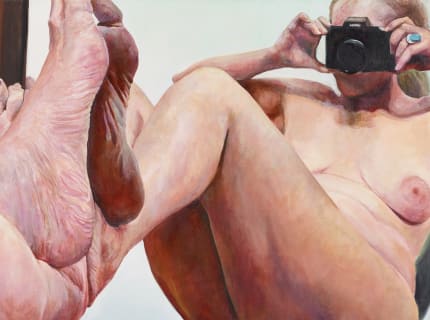OVER THE PAST HALF CENTURY, JOAN SEMMEL has pursued a painterly enterprise that brings extraordinary wit and acumen to representations of the body-most often the artist's own. And this oeuvre has grown increasingly visible in recent years, thanks to a series of institutional exhibitions such as Semmel's solo show at the Bronx Museum of the Arts this past spring. Yet a key moment in the artist's early work, marked by a complex engagement with photography and sexuality, remains relatively little known. Here, art historian RICHARD MEYER considers this period in Semmel's career and traces its importance for her ongoing output as a painter and self-portraitist.
A COLOR PHOTOGRAPH shows a young woman peering through a camera to snap a shot of two naked bodies—one male, one female—intertwined. Horizontally aligned such that neither is on top, the nude figures are severely cropped by the edges of the frame. We see only torsos, legs, and a single, embracing arm. Behind the photographer, a giant painting of another naked couple looms. Mostly what we see of that picture is a woman’s imposing thigh, arm, and breast, all rendered, improbably, in shades of baby blue.
This photograph of the artist Joan Semmel appeared in the January 1974 issue of Viva, a publication that billed itself as the “world’s most sophisticated erotic magazine for women” and that is barely remembered today, except perhaps as the professional launching pad of a young fashion editor named Anna Wintour. Published by Penthouse founder Bob Guccione, the magazine carried articles by and about prominent women (ranging from Simone de Beauvoir to Bianca Jagger) and soft-core photo spreads of naked men, often in pastoral surrounds such as meadows or haylofts. Though easy to ridicule, in retrospect, as equal-opportunity objectification, Viva represented both a genuine response to the feminist movement of the early to mid-1970s and a profit-minded co-optation of it.
Semmel was photographed and interviewed by Viva for a feature article titled “Women in the Erotic Arts,” which boldly proclaimed that “for the first time in the history of art . . . women artists are expressing sexuality on their own terms, reflecting and discovering their own perceptions stripped of traditional mythologies, unfettered by accepted imagery.” The article focused on the members of a loose-knit collective of female artists in New York called Fight Censorship. Founded by the audacious painter and collage artist Anita Steckel, the group included Semmel, Judith Bernstein, Louise Bourgeois, and Hannah Wilke, as well as now lesser-known artists such as Martha Edelheit, Eunice Golden, Juanita McNeely, and Barbara Nessim.

